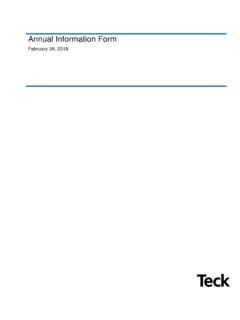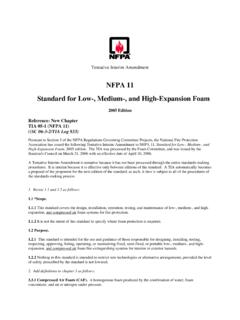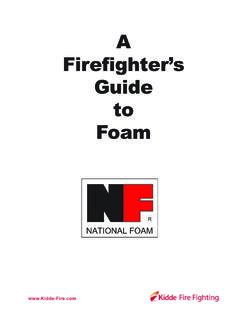Transcription of ZINC CONCENTRATE SAFETY DATA SHEET - Teck
1 June 12, 2015 zinc CONCENTRATE Page 1 of 8 zinc CONCENTRATE SAFETY data SHEET SECTION 1. IDENTIFICATION Product Identity: Red Dog zinc CONCENTRATE . Trade Names and Synonyms: None. Manufacturer: Teck Alaska Incorporated Red Dog Mine Box 1230 Kotzebue, Alaska 99752 Emergency Telephone: (250) 364-4214 Supplier: Teck Alaska Incorporated Red Dog Mine Box 1230 Kotzebue, Alaska 99752 Preparer: Teck Metals Ltd. Suite 3300 550 Burrard Street Vancouver, British Columbia V6C 0B3 Date of Last Review: June 12, 2015. Date of Last Edit: June 12, 2015. Product Use: zinc CONCENTRATE is used in the production of zinc metal and zinc alloys. SECTION 2. HAZARDS IDENTIFICATION CLASSIFICATION: Health Physical Environmental Acute Toxicity (Oral, Inhalation) Does not meet criteria Skin Corrosion/Irritation Does not meet criteria Eye Damage/Eye Irritation Does not meet criteria Respiratory or Skin Sensitization Does not meet criteria Mutagenicity Does not meet criteria Carcinogenicity Category 1A Reproductive Toxicity Category 1A Specific Target Organ Toxicity: Acute Exposure Does not meet criteria Chronic Exposure Category 1 Does not meet criteria for any Physical Hazard Aquatic Toxicity Long Term Category 3 LABEL: Symbols: Signal Word: DANGER Hazard Statements DANGER!
2 May cause cancer through inhalation of dust. May damage fertility or the unborn child. Causes damage to the respiratory system through prolonged or repeated exposure. Harmful to aquatic life with long lasting effects. Precautionary Statements: Obtain special instructions before use. Do not handle until all SAFETY precautions have been read and understood. Do not breathe dust. Wear protective gloves, protective clothing, and eye protection. Wash hands thoroughly after handling. Do not eat, drink or smoke when using this product. Avoid release to the environment. If exposed or concerned or you feel unwell: Get medical advice/attention. Collect all spillage. June 12, 2015 zinc CONCENTRATE Page 2 of 8 Emergency Overview: A dark brown, heavy, soil-like material that is not flammable or combustible under normal conditions of transport and storage. However, when heated strongly in air it will burn, releasing toxic and irritating sulphur dioxide gas as well as possible lead and zinc oxide fumes.
3 Contact with strong acids will generate flammable and highly toxic hydrogen sulphide gas (H2S). Inhalation or ingestion of CONCENTRATE dust may produce chronic health effects. Possible cancer hazard due to lead, cadmium and silica content. Possible reproductive hazard due to the lead content. SCBA and full protective clothing required for fire emergency response personnel. Potential Health Effects: Caution: The toxicological properties of this material have not been fully investigated. The information contained in this SDS is therefore based on information in the technical and scientific literature about the material s constituent compounds. CONCENTRATE dust is irritating to the nose, throat and respiratory tract. Inhalation or ingestion of very high concentrations of CONCENTRATE dust may result in lead and cadmium absorption and possible lead intoxication.
4 Symptoms include headache, nausea, vomiting, abdominal spasms, fatigue, sleep disturbances, weight loss, anemia and leg, arm, and joint pain. Prolonged exposure may also cause central nervous system damage ( , fatigue, headaches, tremors, hypertension), gastrointestinal disturbances, anemia, kidney dysfunction and possible reproductive effects. Pregnant women should be protected from excessive exposure to prevent lead crossing the placental barrier and causing infant neurological disorders. Lead and lead compounds are listed as an A3 Carcinogen (Confirmed Animal Carcinogen with Unknown Relevance to Humans) by the ACGIH. IARC has listed lead compounds as Group 2A Carcinogens (Probably Carcinogenic to Humans). Cadmium is classified as an A2 Carcinogen by the ACGIH and as a Group 1 Carcinogen by IARC. Silica is classified as an A2 Carcinogen by the ACGIH and as a Group 1 Carcinogen by IARC (see Toxicological Information, Section 11).
5 Potential Environmental Effects: zinc CONCENTRATE will likely have minimal direct environmental effects, since its constituent metals have low solubility, and are therefore not highly bioavailable. However, when the product is processed or resides in the environment for extended periods, compound forms of zinc and lead may form which are potentially toxic to aquatic and terrestrial organisms (see Ecological Information, Section 12). SECTION 3. COMPOSITION / INFORMATION ON INGREDIENTS HAZARDOUS COMPONENTS CAS Registry No. CONCENTRATION (% wgt/wgt) zinc Sulphide 1314-98-3 80 to 85% Iron Sulphide 1317-37-9 to 12% Lead Sulphide 1314-87-0 to Silica 14808-60-7 to Cadmium Sulphide 1306-23-6 to Note: See Section 8 for Occupational Exposure Guidelines. SECTION 4. FIRST AID MEASURES Eye Contact: Symptoms: Eye irritation, redness.
6 Gently brush product off face if necessary. Do not rub eye(s). Let the eye(s) water naturally for a few minutes. Look right and left, then up and down. If particle/dust does not dislodge, cautiously rinse eye(s) with lukewarm, gently flowing water for 5 minutes or until particle/dust is removed, while holding eyelid(s) open. If irritation persists, get medical advice/attention. DO NOT attempt to manually remove anything stuck to the eye. Skin Contact: Symptoms: Skin soiling, mild irritation. Wash gently and thoroughly with lukewarm, gently flowing water and non-abrasive soap for 5 minutes, or until product is removed. If skin irritation occurs or you feel unwell, get medical advice/attention. Inhalation: Symptoms: Respiratory irritation. Remove source of exposure or move person to fresh air and keep comfortable for breathing. Seek medical attention if you feel unwell.
7 Ingestion: Symptoms: Stomach upset. If you feel unwell or are concerned, get medical advice/attention. SECTION 5. FIRE FIGHTING MEASURES Fire and Explosion Hazards: Product is not considered a fire or explosion hazard. However, CONCENTRATE will burn if strongly heated in a fire situation, releasing toxic and irritating sulphur dioxide gas (SO2). Contact with strong acids will generate flammable and highly toxic hydrogen sulphide gas (H2S). The ignition temperature of zinc CONCENTRATE is approximately 700 800 C. Extinguishing Media: Use any means of extinction appropriate for surrounding fire conditions such as water spray, carbon dioxide, dry chemical, or foam. June 12, 2015 zinc CONCENTRATE Page 3 of 8 Fire Fighting: Toxic fumes of sulphur dioxide will result from combustion. Fire fighters must be fully trained and wear full protective clothing including an approved, self-contained breathing apparatus which supplies a positive air pressure within a full face piece mask.
8 SECTION 6. ACCIDENTAL RELEASE MEASURES Procedures for Cleanup: Control source of spillage if possible to do so safely. Restrict access to the area until completion of cleanup. Clean up spilled material immediately, observing precautions in Section 8, Personal Protection and using methods that will minimize dust generation ( , vacuum solids, dampen material and shovel or wet sweep). Return uncontaminated spilled material to the process if possible. Place contaminated material in suitable labeled containers for later recovery or disposal. Treat or dispose of waste material in accordance with all local, regional, and national requirements. Personal Precautions: Persons responding to an accidental release should wear coveralls or other protective clothing, gloves and a respirator (see also Section 8). Close-fitting SAFETY goggles may be necessary in some circumstances to prevent eye contact with dust.
9 Workers should wash and change clothing following cleanup of a spill to prevent personal contamination with lead-containing dust. Environmental Precautions: The handling, shipment, storage and processing of this material requires appropriate controls and care to prevent spillage or gradual accumulation in the terrestrial and aquatic environment. Spilled material should be promptly cleaned up. SECTION 7. HANDLING AND STORAGE Health Precautions: Some sulphide concentrates may slowly oxidize in storage and generate sulphur dioxide as well as deplete the oxygen content of a confined space. The atmosphere within confined spaces containing CONCENTRATE must be tested before entry and the area thoroughly ventilated or self-contained breathing apparatus used, if conditions warrant. Handling (Physical Aspects): Avoid excessive heat. Avoid contact with acids, oxidizers and combustible materials.
10 Minimize dust generation and accumulation. Storage Precautions: Store in a cool, dry area. Autoignition: Some sulphide concentrates may oxidize and generate heat which accumulates in storage piles. If material is to be stored for an extended period, the temperature of piles should be monitored. Means of Control: If heating of the CONCENTRATE is detected, the material should be sealed from air or oxygen in one of the following ways: 1. Leave the piles totally intact, do not open them up or try to spread them around. 2. Tamp or compact the surface of the piles. 3. Spray the pile with water. Resort to an organic binder only if needed because it can cause formation of hard lumps and subsequent problems for processing. Suggestions for organic binders include Aerospray 70A Binder, Coherex, lgepal CA-720 and lignin sulphonate, a pulp mill by-product.
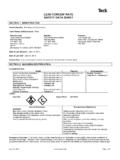
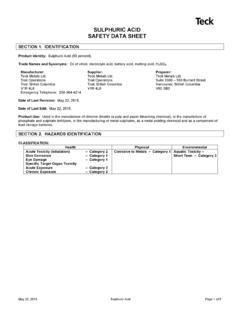
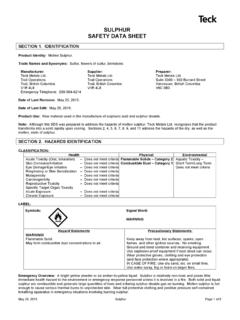
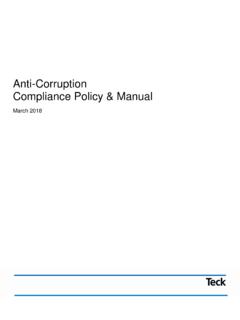
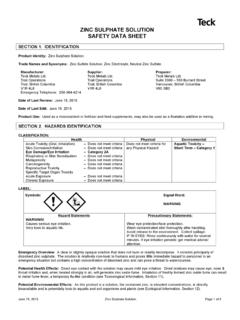
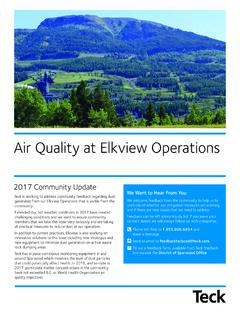
![Lead Metal SDS[2] - Teck](/cache/preview/e/2/d/9/e/e/c/7/thumb-e2d9eec71c9c8be922f6a8aefa2723ab.jpg)
